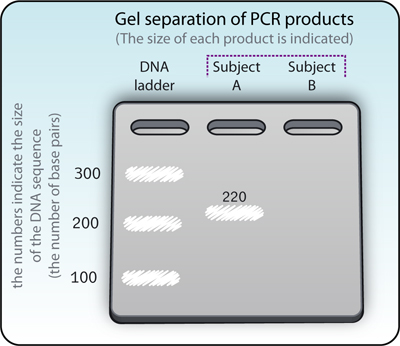The researchers ran two PCR reactions to detect the mutation F508del using the chosen primers, in two DNA samples. The amplification products were separated using gel electrophoresis. The findings are shown in figure 4:

Figure 4: Gel separation of two PCR products from mutation-dependent amplification of two DNA samples, of subjects A and B
22. What do we learn from the findings of the mutation-dependent amplification?
- Subject A is a carrier of F508del mutation in CFTR gene (carries at least one allele) while subject B is a non-carrier of the F508del mutated allele.
- Subject B is a carrier of F508del mutation in CFTR gene (carries at least one allele) while subject A is a non-carrier of the F508del mutated allele.
The answer is: A. In mutation-dependent amplification, a product is obtained only when using DNA sample of a subject that has the particular mutant allele because one of the primers is complementary to a sequence segment of the mutant allele that includes the mutation site. An amplification product was evident while running the reaction using the DNA sample of subject A as a template, which indicates that he/she is a carrier of the F508del mutant allele. At this point one cannot tell if the other CFTR allele of subject A is a normal allele, a similar F508del mutant allele, or a different CFTR allele which carries a different mutation. Since this disease is inherited in an autosomal recessive pattern, we cannot infer whether subject A is sick or healthy. Yet, certainly both CFTR alleles of subject B do not carry the F508del mutation.